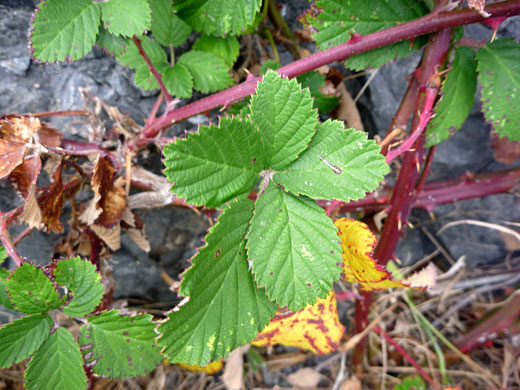Common names:
Armenian blackberry, Himalayan blackberry
Family:
Scientific name:
Rubus armeniacus
Main flower color:
Range:
Mostly in the Pacific and southern states; smaller areas to the north (non native)
Height:
Up to 10 feet - grows at angles, forming arching clumps
Habitat:
Roadsides, other disturbed areas, below 5,000 feet
Leaves:
Divided into 3 or 5 elliptic, coarse-toothed leaflets
Season:
March to August
As the species name suggests, rubus armeniacus is native to Armenia, and adjacent areas of Eurasia, and has been established in various parts of the US. The green or red stems are many feet long, forming tangled clumps. They bear large, widely spaced prickles, wide at the base, brownish at the tip. Stems can be up to one inch in diameter; they have five ribs, and may be hairless or finely hairy. Leaves on flowering stems may be simple or compound, divided into three leaflets, with thread-like stipules at the base. Leaves on non-flowering (first year) stems are always compound, with five (less often three) leaflets. Leaflets have white, tomentose hairs on the undersurface.
Plants produce many white flowers, in clusters along the stems, containing up to 20 heads. Flowers have five hairy green sepals below five larger white to pale pink petals, obovate in shape. At the center are a hundred or more brown-tipped stamens around a group of over 30 yellowish pistils. The fruit is a sphere of drupelets, initially green, ripening to black.
Plants produce many white flowers, in clusters along the stems, containing up to 20 heads. Flowers have five hairy green sepals below five larger white to pale pink petals, obovate in shape. At the center are a hundred or more brown-tipped stamens around a group of over 30 yellowish pistils. The fruit is a sphere of drupelets, initially green, ripening to black.
All Contents © Copyright The American Southwest | Comments and Questions | Contribute | Site Map



